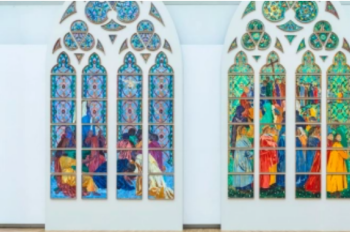
We need to be keenly aware of what God is doing in the present panorama of world missions. Today missionaries from the Majority World (non-West) increasingly join the global workforce, and it is not difficult to meet a Nigerian, Kenyan, or Ghanaian from Africa, a Korean from Asia, or a Brazilian from South America among foreign missionaries. However, some of the missionary strategies they use are merely carbon copies of Western methodologies rather than methods formed in their own contexts that express their cultural attributes. Today, missionaries from the Majority World would naturally find it easier to connect with those of similar backgrounds in other Majority World nations where they are sent to minister. Western methods and models may sit like Saul's armor, uncomfortable and unnatural on young missionary "Davids".
Every culture possesses a valuable heritage to contribute to God's purposes whether local or cross cultural. The Western church possesses an incomparable experience and a rich missions legacy, with much to offer to the global body of Christ. In previous generations, Western missions strategy focused mainly on reaching an under-developed Majority World. Missionaries of the historic modern missionary movement zealously devoted themselves to exploring deep and toiling long to pioneer missionary stations among people without the gospel in remote jungles and villages. The seeds sown were dispersed into the world, established churches, and now those churches are sending missionaries of their own. Missionaries are moving in and from Asia, South America, and Africa, inspired by the sacrificial example of Western missionaries of the past.
With the modern missionary movement that began with William Carey in our rear-view, in my opinion the new era of missions demands a much more focused approach—more attention should be given to reaching smaller tribes and groups that remain under-reached rather than to the masses that already have ready access to the gospel. Different generations minister to different contexts, which call for different assignments in the grand missio Dei (mission of God). Paul said, "I planted the seed, Apollos watered it, but God has been making it grow" (1 Corinthians 3:6). God has raised different ethnicities for missions at different times in history for a specific purpose. God chooses them and their ethnic backgrounds in fulfillment of God's covenant to Abraham, that his offspring (including his children by faith) would be a blessing to the nations (Genesis 12:2–3).
Korean/Asian distinctives
For instance, Koreans have developed over the centuries three cultural distinctives that are evident in their concepts of communication: chae-myun, kibun, and nunchi. Similar to other Asian cultures, Koreans emphasize the importance of chae-myun (commonly translated as face-saving) which highly values reputation, influence, dignity, and honor. They would consider disguising one’s true feelings and putting on a stoic face to be respectable. Kibun and nunchi concepts are rather unique to Koreans. Kibun can be vaguely translated as mood, while nunchi points out one’s sense of assessing others’ moods (kibun). Because Korean cultural heritage has a strong honor-orientation, its collectivist and face-saving elements can shorten the process of cultural adaptation in surrounding nations and Asia at large, where parallel cultural notions are upheld. What is considered honorable (or dishonorable) varies by ethnic group, area, and generation. So, because honor codes may be diverse and often personal, Korean missionaries still have fewer cultural adjustments to make in order to adapt to another honor-oriented culture.
Indigenous cultural practices could be interpreted as deceitful if they are implemented with wrong motives. On the other hand, they can positively serve as tools to increase sensitivity to the needs of the host culture. It is a great intercultural feature for Koreans to be keenly observant of the local people and their behaviors on the mission field. Sensitively understanding and caring for the needs of others through the eyes of kibun and nunchi can demonstrate Christlike humility in serving others. Korean and other Asian missionaries should consider applying the concept of chae-myun to motivate and encourage local Christians with similar cultural traits to grow in their spiritual maturity and independence from missionaries. With these cultural connections and natural benefits, new workers from Korea, and Asia in general, should engage in missions with more confidence.
Brazilian/South American distinctives
Samba dance and the Brazilian carnival festival symbolize the passionate and fun-loving cultural traits of Latin Americans. Brazilians’ enthusiastic preparation and investment in the annual carnival event attracts attention worldwide. Excitement and passion for the kingdom life, rather than indulging in carnal desires, can be also be born out of these same cultural traits. When this passion is channeled to gospel sharing and relationship building, it serves as a witness of a joyous kingdom lifestyle. To South American Christians, undivided devotion to worship is paramount. Their worship portrays and creates an atmosphere of heaven on earth. Our God, an expert in turning ashes into a crown of beauty (Isaiah 61:3), has been using this cultural trait to raise Brazilian cross-cultural workers to bring the gospel to the nations, as evidenced by Brazil being listed as the second runner-up in the number of missionaries sent in in 2010.
Kenyan/African distinctives
In our era of missions history, missionaries from Nigeria, Kenya, Ghana, and Africa in general are increasingly found reaching out to fellow Africans and evangelizing post-Christendom Europe. We have seen this in operation at the Evangelical Alliance for Preacher Training/Commission (EAPTC) where we are raising Kenyan missionaries to reach their own continent with fewer cultural hurdles to overcome. At the dawn of the 21st century, when we opened our missions training school in Nairobi, it was still a rare event. However, it seemed the Lord was pleased by our mere obedience and the resilient spirit of our Kenyan missionaries, and blessed us with fruit in the years that followed. It was through the efforts of those Kenyan cross-cultural gospel workers that our work expanded into scores of Bible training centers and hundreds of new church plants in numerous African nations.
Implications for contemporary world missions
One of the most strategic things the global body of Christ can be doing in our current era of global missions is to develop missionaries who will cultivate their own cultural uniqueness.
One of the most strategic things the global body of Christ can be doing in our current era of global missions is to develop missionaries who will cultivate their own cultural uniqueness, utilize it for God's purposes in the world, and take it to reach under-reached groups with similar cultural backgrounds. We must not merely replicate the standardized methods of Western missions of the past, but find and facilitate our own cultural approaches that are suitable for missions today among people with similar cultural traits. We need to be open to the multifaceted nature of missions, which is not just a one-dimensional model of reaching the world driven by traditional missions history. As the world is expected to become more diverse and complex in the future, it is now time to consider multi-directional methodologies.
Handpicked missionary candidates who are not afraid of healthy analysis of their own cultures, who learn to understand cross-cultural contextualization of the gospel, and who willingly go to near-culture under-reached people, will accelerate God's mission. Missionary screening processes and pre-departure training should also include guidance to help candidates discover and understand their cultural strengths more deeply. Those cultural strengths can be tailored and contextualized into personalized ‘missionary clothing’ better suited to them than the uncomfortable suit of the traditional missionary. We all go out in the name of the Lord Almighty (1 Samuel 17:45), but we ought to go out with the "stones" we are familiar with, not with "Saul’s armor". Every national church should advance with a missionary strategy that is conversant with its home culture and at the same time tailored relevantly to the field culture.
Considering the statistics that the remaining under-reached areas of the world are found in Creative Access Regions (CAR), where anti-Western sentiment is high and mass evangelism hardly takes place, this strategy can help missionaries and missions leaders find ways to access. I believe that is why God has been raising more Majority World missionaries over the past forty years, those who are accustomed to a less prosperous and often developing world. Majority World missionaries possess cultural attributes that can be advantageous for the gospel if they are adequately utilized. They are God-given resources (grace) that every global Christian can use from their cultural background, to cultivate for Christ’s service.
A version of this article originally appeared in the March 2024 issue of the Lausanne Global Analysis and is published here with permission.
Paul Sungro Lee is the international director of the Evangelical Alliance for Preacher Training/Commission (EAPTC), a ministry that trains Christian leaders and facilitates church planting worldwide. He holds a PhD from Omega Graduate School (ACRSS) and is an adjunct faculty member at Bakke Graduate School. A scholar-practitioner of world mission, Dr Lee is the author of several books, including Doing Missions in Difficult Contexts. He is married to Eunice, and they have two adult children.
Lausanne Global Analysis seeks to deliver strategic and credible information and insight from an international network of evangelical analysts to equip influencers of global mission. To receive this free bimonthly publication from the Lausanne Movement, subscribe online at https://lausanne.org/global-analysis.





